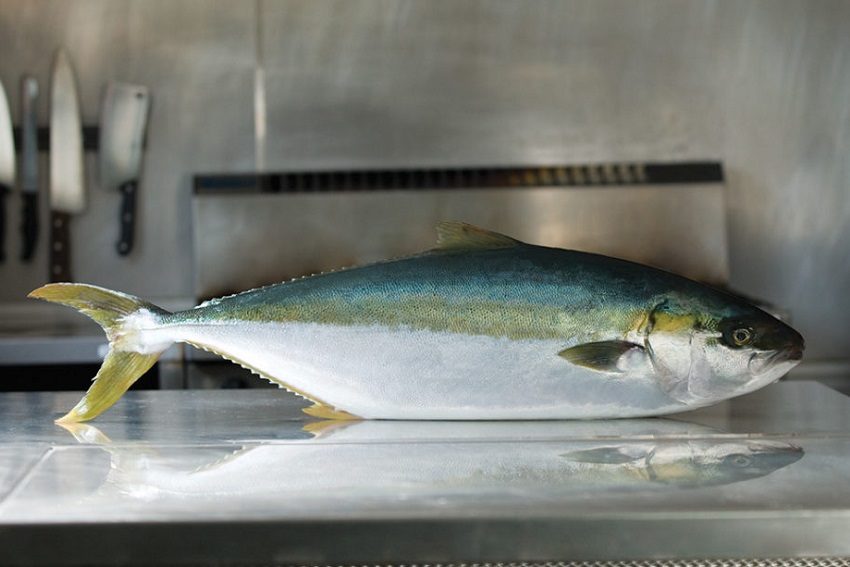Hiramasa Kingfish: SA's aquaculture monarch

The recently rebranded Spencer Gulf Hiramasa Kingfish is one of South Australia’s great seafood export success stories — but the bold fish farming venture very nearly collapsed before fulfilling its potential.
It’s the ingredient that has finally given local chefs the confidence to present an array of raw fish dishes on their menu – ceviche, sashimi, even playful ideas of fish tartare. Spencer Gulf Hiramasa Kingfish, farmed by Clean Seas in pens moored within Port Lincoln’s Boston Bay, is also being grilled, steamed and baked to assume myriad starring roles in restaurants. It has been voted best fish at the Australian Food Awards in 2016 and 2017, with some chefs even saying it rivals King George Whiting as their favourite South Australian fish.
“The texture and quality of Hiramasa kingfish flesh is amazing,” says chef Paul Baker of Botanic Gardens Restaurant. “It’s consistent, and it’s sustainable because it is being farmed, which is a big part of why it is always on my menu.”
The Clean Seas product — which is Australia’s only commercially farmed yellowtail kingfish — has adopted the Japanese name for the species, Hiramasa, to differentiate it as a farmed fish, and avoid it being confused with the diminishing stocks of wild kingfish.

The rise of kingfish is one of the great success stories of recent food product development in SA. However, it so nearly crumbled to dust only a few short years ago, when the notion of farmed kingfish being developed from fingerlings appeared to be a commercial folly.
It began as the brainwave of Hagen Stehr, the wealthy and successful German-born Port Lincoln tuna fisherman, whose original idea of developing Bluefin tuna from fingerlings was soon superseded by kingfish, a finfish species native to Spencer Gulf, and prized by the Japanese for its quality as sashimi.
Stehr’s company identified commercial potential after some initial farming trials from 1998, and acquired an existing licensed finfish hatchery at Arno Bay in 2000 to produce fingerlings of large finfish species. Successful production of kingfish fingerlings began in 2001, harvesting commercial quantities of the fish commenced in 2004, and the company was listed on the Australian Stock Exchange in 2005, with a capital expansion program transforming the Arno Bay site into a world-class facility.
Disaster struck in 2012; intestinal illness called gut enteritis was killing more than 35 per cent fish before they reached maturity. Share prices fell and staff had to be laid off during the three years it took to find a solution. It was only dogged determination, along with the lure of high prices for kingfish here and overseas (selling at almost $50 a kilogram for fillets) that kept Clean Seas persevering, and finally a breakthrough occurred: it was discovered that a lack of the trace element strontium in feed being issued to kingfish in the ocean pens was proving fatal. Correcting the feed resulted in immediate success.

Clean Seas has now perfected its process. The life cycle of Spencer Gulf Hiramasa Kingfish commences with eggs harvested from farmed broodstock, then transferred to an incubator, where they hatch 48 hours later. After the larvae spend 21 days in custom-designed rearing tanks and grown to exactly 0.1 grams, these tiny kingfish are transferred to a nursery within the Arno Bay complex and weaned on specially formulated feed.
At 80 days after hatching, the 35-gram fingerlings are transported by helicopter to open sea pens in the lower Spencer Gulf, at three times a year — in September, November and February. This ensures constant supply of full-sized kingfish throughout the year.
By late 2017, the commercial success of Hiramasa Kingfish had consolidated, built on the delivery of consistent fish sizes and quality, and propelled by a new marketing campaign that identifies the provenance of the fish, its consistent quality and size (endorsed by chef ambassadors around the nation, including Giovanni Pilu of Pilu At Freshwater in Sydney and Victor Liong at Lee Ho Fook in Melbourne) and sustainability. Clean Seas has earned endorsement by the Friends of the Sea for kingfish compliance to its criteria for Sustainable Fisheries.
Clean Seas is currently producing and processing about 2800 tonnes of its kingfish annually, amounting to sales of $47 million (an increase of 25 per cent on the previous year). Around 45 per cent is exported.

A key to the growth of Spencer Gulf Hiramasa Kingfish sales has been the company’s decision to control all its own processing, with a processing facility built at Royal Park in Adelaide with rapid freezing technology (liquid nitrogen) and Adelaide’s first -40C freezer facility.
Sustained demand has now triggered plans to increase production, with Clean Seas confident it has as the capability to more than triple its kingfish output. This begins with the introduction of up to 20 more ocean pens planned for Fitzgerald Bay near Whyalla in August — and value-added products will emerge from its Adelaide processing facility in the next year, such as smoked fish, pre-sliced sashimi cuts and possibly even ceviche and tartars.
“This is a whole new world for us,” says Clean Seas CEO David Head. “It’s driven by a new marketing campaign that will take us into 1400 restaurants around the world, and our serious investment in technology — which will result in quite a lot more jobs being generated. We’re confident we have the product to sustain this, and to grow even further.”